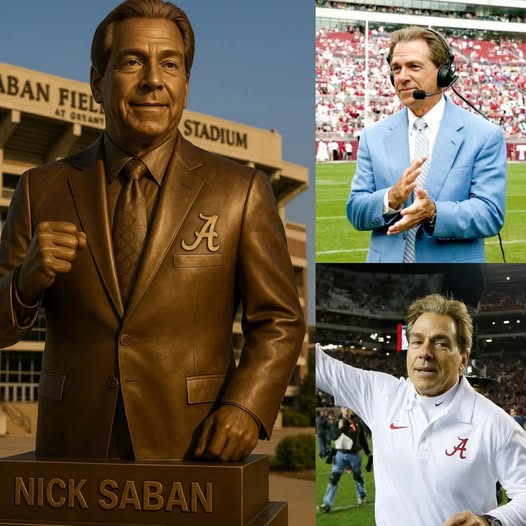The University of Alabama has long been a bastion of college football excellence, a program where legends are forged and dynasties are built. But no figure has loomed larger over the sport in the modern era than Nick Saban, the architect of the Crimson Tide’s unparalleled dominance. Now, as if to etch his legacy permanently into the annals of college football history, the university has approved a \$2.1 million bronze statue of the legendary coach to stand outside the newly renamed Saban Field at Bryant-Denny Stadium. This monumental tribute ensures that Saban’s influence—both on and off the field—will endure for generations to come.
The decision to immortalize Saban in bronze is hardly surprising. Since arriving in Tuscaloosa in 2007, he transformed Alabama football from a storied program into an unstoppable force, securing six national championships and cementing the Crimson Tide as the gold standard of college football. His relentless pursuit of perfection, his ability to adapt, and his uncanny knack for developing NFL-ready talent made him not just a coach but a cultural icon in the state of Alabama. The statue, set to be unveiled in 2025, will join the ranks of other Alabama legends immortalized around the stadium, including Bear Bryant, whose own statue has stood as a symbol of excellence for decades.
The \$2.1 million price tag reflects not just the craftsmanship of the sculpture but the magnitude of Saban’s impact. The statue will depict Saban in his signature pose—arms crossed, a look of quiet intensity on his face—capturing the essence of a man who demanded excellence from everyone around him. It will stand at the entrance of Saban Field, a newly designated section of Bryant-Denny Stadium, ensuring that every player, recruit, and fan who walks into the hallowed grounds will be reminded of the standard he set. The project has been met with overwhelming approval from alumni, boosters, and fans, many of whom view it as a long-overdue tribute to the man who restored Alabama to its rightful place atop the college football world.
But the statue is more than just a celebration of wins and championships. It is a recognition of Saban’s broader influence on the university and the sport itself. Under his leadership, Alabama became a pipeline for NFL talent, with countless players—from Julio Jones to Derrick Henry to Tua Tagovailoa—crediting Saban for their development. His “Process” became more than just a coaching philosophy; it became a life lesson for players and students alike. Beyond football, Saban and his wife, Terry, made significant contributions to the Tuscaloosa community, including millions donated to scholarship funds and disaster relief efforts following the 2011 tornado. The statue, then, is as much a tribute to his humanity as it is to his coaching genius.
Critics might argue that erecting a statue to a living coach is premature, but in Saban’s case, it feels inevitable. His retirement in January 2024 marked the end of an era, and the university wasted no time in ensuring his legacy would be forever enshrined. Unlike Bear Bryant, whose statue was unveiled years after his retirement, Saban’s tribute comes at a time when his influence is still fresh, his impact still reverberating through every corner of the program. Current Alabama coach Kalen DeBoer, tasked with the unenviable job of following a legend, has already spoken about the importance of honoring Saban’s foundation while carving out his own path. The statue serves as both a tribute and a challenge—a reminder of what Alabama football should always aspire to be.
The artistic process behind the statue has been a meticulous one. The university commissioned renowned sculptor Sandra Wetmore, whose previous works include iconic sports figures like Michael Jordan and Vince Lombardi. Wetmore spent months studying Saban’s mannerisms, reviewing footage, and even meeting with former players to ensure the statue captured not just his likeness but his essence. “You don’t just sculpt Nick Saban’s face,” Wetmore said in an interview. “You sculpt his presence. The way he commanded respect without saying a word, the way his gaze could silence a room—that’s what we wanted to translate into bronze.” Early renderings of the statue have drawn rave reviews, with many noting how perfectly it encapsulates Saban’s steely determination.
The location of the statue is equally symbolic. Positioned at the entrance of Saban Field, it will serve as a literal and figurative gateway to Alabama football’s future. Every recruit who visits campus will walk past it, a silent but powerful reminder of what they could become under the Crimson Tide banner. Every player will see it on game day, a call to uphold the standard Saban set. And every fan will gather around it, not just to take photos but to reflect on the golden era he created. In many ways, the statue is more than art—it’s a monument to a way of thinking, a belief that excellence is not an accident but a habit.
The financial commitment to the project has been a point of pride for the university. Funded entirely through private donations, the \$2.1 million cost was raised in record time, a testament to the loyalty of Alabama’s fanbase. Prominent boosters, former players, and even rival coaches contributed, underscoring the universal respect Saban commanded across the sport. “This wasn’t just about football,” said one donor. “This was about honoring a man who changed lives. Whether you played for him or just watched from the stands, Nick Saban made you believe in the impossible.”
As the unveiling date approaches, anticipation continues to build. The ceremony is expected to draw thousands, including former players, coaching peers, and media from across the country. It will be a celebration not just of Saban but of what he represented—discipline, resilience, and an unyielding commitment to greatness. And when the curtain finally drops, revealing the gleaming bronze figure for the first time, it will mark more than just the honoring of a coach. It will be the immortalization of an era.
Nick Saban’s legacy was never in doubt. But now, cast in bronze and standing tall outside Saban Field, it is set in stone. For as long as Alabama football exists, his presence will loom over the program—a silent, steadfast reminder of what it means to be the best. And for those who pass by his statue in the years to come, the message will be clear: This is the standard. This is the Process. This is what it means to be Crimson Tide.



